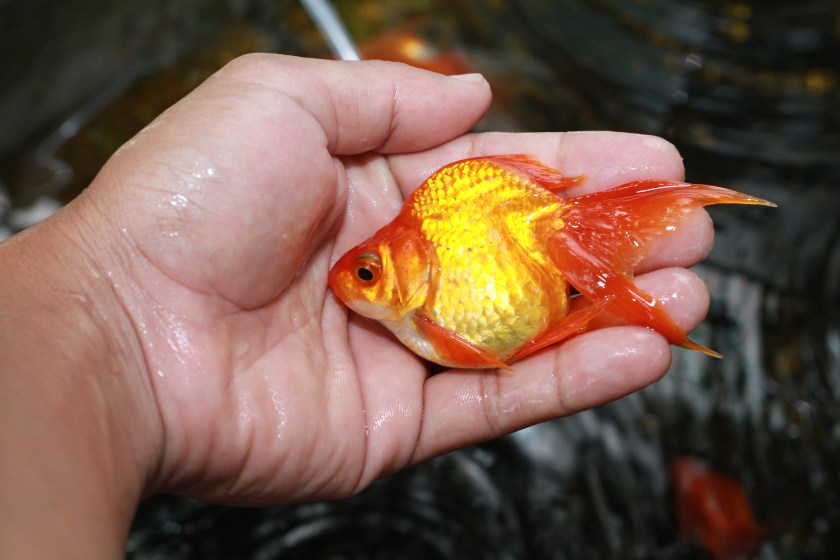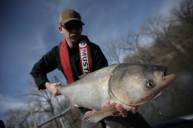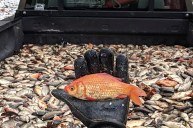Last year, British angler Andy Hackett hooked a 67-pound goldfish, a behemoth of a fair prize, in France's Champagne-region BlueWater Lakes. Yes, that's right—a giant goldfish, the size of a Belgian sheepdog.
The Carrot, as the fish was named later, is an extreme example of what can happen when a pet goldfish is released from its glass bowl into a bigger waterway. While The Carrot was intentionally re-homed to a private French fishery, where it grew to be the largest goldfish ever caught, people have been "re-homing" household goldfish into wild waterways for decades.
In the open water, goldfish flourish to become giants, thanks to their voracious eating habits, rapid reproduction rates, and ridiculously high tolerance for low-quality waters. Massive goldfish are now outcompeting native fish for essential resources by shredding aquatic vegetation and muddying the water to unlivable levels for trout, chubs, and many others.
And the impacts of giant goldfish invasions stretch far beyond the aquatic realm, explains Jenna White, invasive species policy coordinator for the Canadian Invasive Species Centre (ISC) in Ontario.
"Goldfish impacts are actually ecological, economic, and social," she says. "Not only do they cause an ecological imbalance and potentially create monocultures, but they could also impact recreational fishing, which contributes about $556 million annually to Canada's economy."
Invasive goldfish may not be coming to feed on your water wing-clad kids like a Sci-Fi Channel B-movie, but they are devastating water systems in Canada, the United States, and other countries around the world.
How Did the Giant Goldfish Invasion Start?

Getty Images, Jerry Redfern
Like many familiar stories that end with a foreign species going rogue in a new land, the genesis of the current massive goldfish problem was presumably early settlers' desire for "a little slice of home."
According to the United States Geological Survey (USGS), goldfish began finding their way from eastern Asia and Europe into North American water systems as early as the 1600s. Settlers simply wanted to enjoy them in their new waterways—way before misinformed fish parents were looking to ditch their unwanted pets.
Bearing the distinction of "the first foreign fish species to be introduced to North America," goldfish became a nice addition to decorative ponds and water gardens, just as they had in China. They made for the original koi carp pond, if you will.
As such, the former U.S. Fish Commission (the present-day U.S. Fish and Wildlife Service) went into full goldfish production mode. It raised them in hatcheries to meet the demand for baitfish and ornamental species. Thousands of goldfish were then shipped to various states and given away as novelties at carnivals.
By the late 1800s, the crucian carp and common koi carp hybrid had reached the West and everywhere in between, even Hawaii. Since then, more carp species have interbred to create the various hybrids we now know as the household goldfish; the world's biggest goldfish, The Carrot, for example, was actually a hybrid species of a leather carp and koi carp.
Sure, it all started innocently enough. But with a few hundred years of naturalization, 21st century invasive species managers are already way behind the large-goldfish power curve.
The Growing Problem of Giant Goldfish

Getty Images, South China Morning Post
In the last couple of decades, the situation has only become worse as more people discard their former fish friends into lakes, rivers, and even stormwater retention ponds.
"People releasing unwanted goldfish is the primary reason we are seeing this problem," White tells Wide Open Spaces. "Goldfish are found throughout Canada, but the current issue is mostly concentrated in Ontario, especially Hamilton Harbour and other areas that are more urbanized and in close proximity to humans."
She adds that her team once found 20,000 goldfish in a stormwater pond. "It's easy and convenient to release them into these ponds because they're near people's homes," she says.
These "footballs with fins" invasive fish can now be found all throughout Canada, as well as in all 50 states in the U.S. Alaska was the last holdout until wildlife officials began finding a handful of non-reproductive populations in 2018. However, in most of the U.S., the large-goldfish threat level appears to vary within any given state.
Minnesota's Keller Lake became famous in 2021 when anglers caught some 28 football-sized goldfish in two weeks. New York was one of the first states with a reproducing goldfish population in the early 1800s, but the Empire State doesn't appear to have a significant problem, according to the New York State Department of Environmental Conservation.
The western U.S. checks in with similar good news, at least in one famous lake. "They're really not a huge problem in Lake Tahoe," says Kevin Netcher, aquatic invasive species coordinator with the Nevada Department of Wildlife "They are present, but goldfish are pretty much kept in check based on water quality. It gets pretty cold in Tahoe, and there are also fish like 'big mouth' that eat them."
Why Goldfish Have Thrived

Getty Images, phongkrit
One of the remarkable attributes of goldfish is their ability to reproduce quickly and flourish in various environments. Producing thousands of eggs multiple times a year, a single female goldfish can spawn 2,000 to 380,000 offspring.
Coupled with what White calls their "hardiness and the ability to survive anywhere," goldfish can thrive in low-oxygenated, warm, and polluted waters—waters that are far worse than what salmon, trout, and other native fish species can tolerate. In other words, they can thrive in almost any environment.
Goldfish's adaptability results in exponential population growth that is difficult to manage. Massive goldfish check nearly every box of a "super-invader"—a specific category of invasive species with exceptional characteristics that allow it to dominate environments.
One thing is for sure: They aren't going down without a fight.
The Bigger Ecological Disaster Goldfish Create

City of Burnsville
Goldfish have an insatiable appetite; they root through the mud and devour vast quantities of vegetation, invertebrates, fish eggs, and larvae. And the larger the goldfish, the greater the damage.
This feeding frenzy of both young and adult fish stirs up sediment. Those sediment particles float through the water column, decreasing clarity (increasing turbidity), which then severely limits the essential sunlight that aquatic plants need to grow.
Ultimately, those aquatic plants—which provide oxygen, shelter, and food sources for other organisms—are decimated. Nutrients in the sediment are also released, contributing to increased toxic algal blooms. What's left are barren habitats where life struggles, and native fish die off.
This is exactly the situation at Maple Lake in Utah. Biologist Chris Crockett with the Utah Division of Wildlife Resources told KSL NewsRadio in a 2018 podcast that the lake was so overrun by large goldfish that the resulting pollution was killing the native trout—and the only thing they could do to restore it was eradicate everything left in the 5-acre lake and start over.
Although Lake Tahoe isn't currently a problem region, Netcher notes one area of concern regarding invasive goldfish: "One of the biggest problems we have with them in Nevada is we have many endemic species—species that are only found in one location or spring source," he says. "When people introduce goldfish to those locations, it can potentially cause extinctions."
That's especially an issue when it comes to fish also listed under the Endangered Species Act, such as the speckled dace of Soldier Meadows Hot Springs. Goldfish in the water system is the primary challenge to the recovery potential of the endangered speckled dace. "They just compete for the same resource and limit the population of speckled dace that are present," Netcher says.
How Do We Reel In the Invasion of Giant Goldfish?

Getty Images, George Melin
Many non-native fish species can be managed through consumptive use, but fishing goldfish to help control the population isn't so appealing: To most people, the culinary appeal of a goldfish rivals that of a raccoon. With grayish, unappetizing-looking meat and a flavor that is similar to the "muddiest" of tilapia, eating goldfish is a hard pass for many.
Besides catch and release for sport, angling is not a very effective management tool for the species. So what is to be done about the nightmarish giant goldfish invasions that are occurring in Canada and the U.S.?
1. Educate the Public Not to Release Pets into the Water
They say an ounce of prevention is worth a pound of cure: "Reducing the spread of goldfish is as simple as not letting them loose in the wild," the ISC states on its website.
But how do you get pet owners to take responsible action?
"We try to get people to think about their pet-buying decisions through pre-purchase education at the pet stores," White says. "Messaging is the key thing."
She and the ISC work with pet industry influencers to get this key messaging out. They also partnered for the Canadian Don't Let it Loose program, which spreads this messaging at pet stores to better educate people. Indeed, Netcher's agency runs a similar program in Nevada.
Educating pet owners about the risks of releasing pet fish and promoting responsible pet ownership are essential to keep other water bodies from turning into Maple Lake.
2. Controlling and Eradicating Existing Populations
Well-established, large goldfish populations are exceedingly difficult to manage. At that point, control efforts focus on physically or chemically reducing goldfish populations first, then restoring native species and habitats.
These efforts may involve resource-intensive techniques such as targeted removal using traps and nets, electrofishing, or introducing natural predators that prey on goldfish. Sometimes, it's necessary to take drastic measures. If warranted, the use of the pesticide rotenone may be used to take out all of the fish in a pond that is beyond saving.
"Because it kills all fish, we only use it in very select scenarios," Netcher says. In one instance, the Nevada Department of Wildlife had to employ it in a popular fishing pond near Las Vegas. Goldfish had been introduced there, and anglers looking to hook a trout were pulling out goldfish instead.
"It finally got to the point where we had enough complaints about it and decided to just eradicate the entire pond," says Netcher. "We rotenone-d all the goldfish out and, in the following years, reintroduced the trout fishery."
The Bottom Line: Don't Let Pet Goldfish Loose

Facebook, Buffalo Niagara Waterkeeper
While the task of effectively managing the large-goldfish invasions seems daunting, the collective efforts and dedication of invasive species experts and concerned citizens provide a positive outlook. Taking an adaptive management approach involving research, public engagement, and targeted interventions, it's possible to reduce invasive goldfish introductions.
White reminds us that we all have a part to play: "Individuals can play a role in protecting natural ecosystems from giant goldfish or other harmful species by educating themselves on what they own or are planning to purchase—whether it's fish, house plants, water garden plants, or bait for fishing," says White. "Slowing the spread of invasive species can be as simple as not letting it loose."
Don't cue the Jaws theme just yet. If pet owners heed White's words, we can keep goldfish from worldwide domination.
READ MORE: What You Need to Know About the Invasive Snakehead Fish




